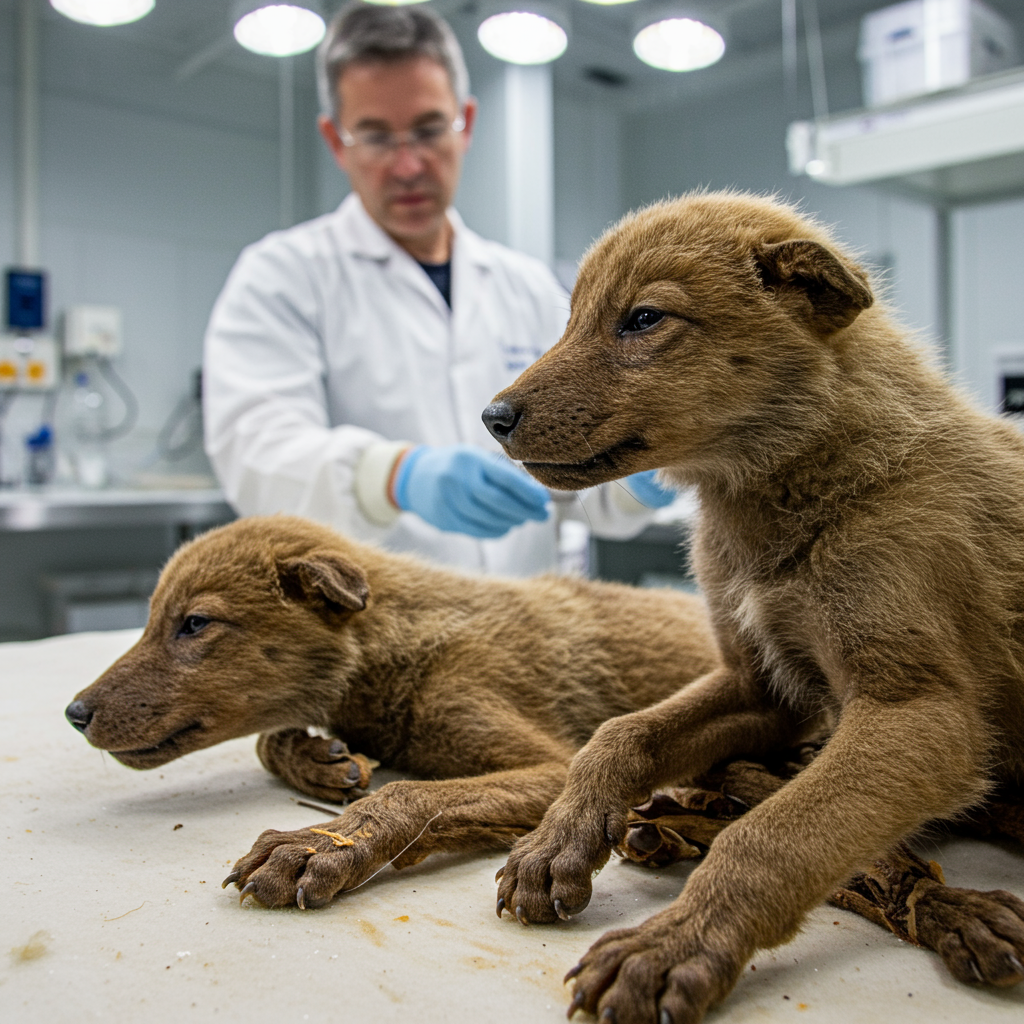Unraveling the 14,000-Year-Old Secret of Siberia’s Tumat “Puppies”
For years, two remarkably well-preserved ancient canids, discovered frozen in Siberia, held a captivating secret. Found in the permafrost near the village of Tumat, these approximately 14,000-year-old specimens, dubbed the “Tumat Puppies,” sparked intense scientific debate. Their location alongside woolly mammoth bones showing evidence of human activity led some researchers to propose an exciting theory: could these be the earliest known domesticated dogs, or perhaps tamed wolves associated with prehistoric hunters?
Now, a comprehensive new study has finally solved this long-standing mystery, revealing the true identity of the Tumat Puppies and offering surprising insights into their lives in the Late Pleistocene era.
Advanced Analysis Identifies the Ancient Canids
An international team, spearheaded by the University of York, undertook a detailed investigation to determine the Tumat Puppies’ origins and connection to humans. Moving beyond simple association, they employed sophisticated techniques, analyzing genetic data recovered from the contents of the pups’ guts and examining chemical fingerprints locked within their teeth, bones, and tissue. The primary goal was to find evidence in their diet or physical makeup that would confirm a link to human activity, particularly the consumption of mammoth meat, which would be expected if they were early domesticates scavenging at a human kill site.
Their findings, published in the journal Quaternary Research, offer a definitive answer that challenges previous assumptions.
Not Dogs, But Ancient Wolves
To the potential disappointment of those hoping for a breakthrough in dog domestication history, the study concluded that the Tumat Puppies had no discernible association with mammoth butchering activities and, consequently, no clear link to ancient humans. The crucial evidence? There was absolutely no sign of mammoth consumption in their diet.
The researchers reasoned that if these young canids had been early dogs or tamed wolves living alongside humans at a mammoth processing site, they would almost certainly have consumed some mammoth remains. The absence of such evidence strongly indicated they were living independently of human hunting camps.
Instead, the analysis pointed conclusively to a different identity: these were ancient wolves. Genetic data further supported this, aligning with previous research that identified the cubs as belonging to a now-extinct population of wolves unrelated to modern dogs.
A Surprising Last Meal: Woolly Rhinoceros
While the lack of mammoth was significant, the scientists made another remarkable discovery about the pups’ diet. Analysis revealed they had a diverse diet, including both meat and plants, much like modern wolves. But their final meal contained something unexpected: woolly rhinoceros.
This finding was particularly surprising. Woolly rhinos, even young ones, would represent a significant challenge for individual wolves. This suggests that the pups likely received this meal from adult members of their pack who successfully hunted or scavenged the large prey animal. The presence of undigested woolly rhinoceros skin in one pup’s stomach indicates they died shortly after this substantial meal.
The size disparity between modern wolves and woolly rhinos hints that these Ice Age wolves may have been larger or hunted cooperatively in packs capable of taking down such ambitious prey.
Glimpses into an Ancient Wolf Pack’s Life
Beyond their surprising menu, the study offered rich insights into the lives of these ancient wolves. The analysis confirmed that the Tumat Puppies were littermates, likely sisters. The presence of physical evidence indicating they were still nursing highlighted that they were young and still reliant on their mother.
Furthermore, the fossilized plant remains in their guts provided clues about their environment, suggesting they inhabited a dry, relatively mild region during the Late Pleistocene, with diverse vegetation and ecosystems.
“We have an insight into their breeding behaviours too,” noted co-author Nathan Wales from the University of York. “The pair were sisters and likely being reared in a den and cared for by their pack—all common characteristics of breeding and raising of offspring in wolves today.” This paints a picture of a typical wolf pack structure and behavior thousands of years ago.
The study also addressed the pups’ distinctive black fur. This coloration was previously thought to be a mutation found primarily in domestic dogs, leading some to believe the Tumat specimens might be dogs. However, finding this trait in ancient wolves challenges that assumption and adds another layer of complexity to the ongoing scientific effort to pinpoint exactly when and where dogs were first domesticated.
In conclusion, the Tumat Puppies, while not the early dogs some hoped for, have provided invaluable data. Their study significantly enhances our understanding of Late Pleistocene wolf behavior, diet, environment, and genetics, demonstrating that wolves from over 14,000 years ago shared remarkable similarities with their modern descendants, even while navigating a world of mammoths and woolly rhinos.




